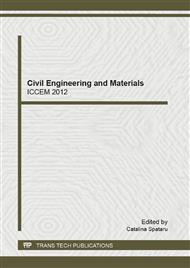p.1
p.6
p.11
p.16
p.21
p.26
p.31
p.36
p.42
A Study on Hardened State Properties of SCC Using Fly Ash and Blended Fine Aggregate
Abstract:
The aim of this research is to investigate hardened state properties of Self Compacting Concrete (SCC) containing low calcium based fly ash. The mixtures were prepared using various proportions of Class F fly ash ranging from 0% to 30% cement replacement. Water to powder ratio is 0.38 – 0.39 and powder content was kept constant at 540 kg/m3. Properties investigated were strength properties (compressive strength and splitting tensile strength), and durability properties (complete immersion water absorption, apparent volume of permeable voids (AVPV), sorptivity, and RCIPT tests. These tests were done at various days. Results showed that fly ash replacement of up to 30% gave acceptable strength and durability properties for medium strength SCC.
Info:
Periodical:
Pages:
21-25
Citation:
Online since:
November 2012
Authors:
Price:
Сopyright:
© 2012 Trans Tech Publications Ltd. All Rights Reserved
Share:
Citation:


